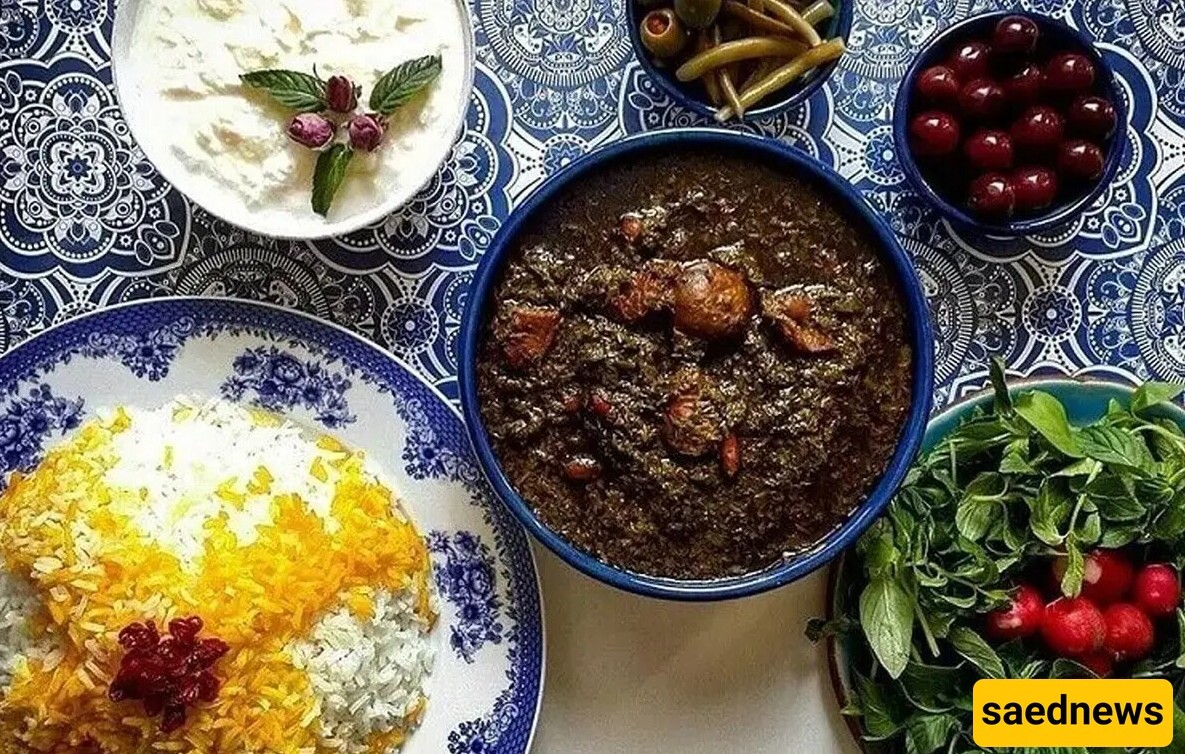Saad News: Tehrani Ghormeh Sabzi doesn't differ much from other regional versions of Ghormeh Sabzi, but there are a few key tips that we will teach you. Make sure to read through the end for crucial tips, as applying these can help you make the perfect Ghormeh Sabzi, just like a professional chef.

According to Saad News's culinary service, Ghormeh Sabzi is a classic Persian dish known for its exceptional aroma, flavor, and taste. It's rare to find someone who doesn't love this amazing dish. Interestingly, it is made in different ways in each region of Iran. Today, we will teach you how to prepare Tehrani-style Ghormeh Sabzi. The first difference in preparation comes from the type of greens used in the dish and their proportions. In Tehrani-style Ghormeh Sabzi, equal amounts of leeks, parsley, and a bit of fenugreek are used. On the other hand, in southern regions like Fars and Khuzestan, the mix includes equal parts of parsley, leeks, coriander, spinach, dill, fenugreek, and green garlic. In the Azerbaijan province, leeks are predominant, followed by parsley, coriander, spinach, and a little tarragon. Generally, the most common proportions for Ghormeh Sabzi are leeks, parsley (half the amount of leeks), coriander (half the amount of parsley), and a bit of fenugreek and spinach (in equal amounts). In addition to the amount of herbs, the way the herbs are chopped is also very important, as it influences the color and consistency of the stew. It’s best to finely chop the herbs. Another difference in Tehrani Ghormeh Sabzi is the type of beans used. Some people use chickpeas or black-eyed beans, while Tehrani Ghormeh Sabzi is typically made with red beans (and sometimes chickpeas).

Now, let’s move on to the recipe for making Tehrani Ghormeh Sabzi, an incredibly delicious dish that you can prepare at home. While the method isn't vastly different from other versions, there are key techniques to keep in mind, which we will teach you. Don’t miss out on these tips at the end, as they will help you make the best Tehrani Ghormeh Sabzi, just like a professional chef. Tehrani Ghormeh Sabzi can be an authentic Iranian dish for parties and gatherings.
Ingredients for Tehrani Ghormeh Sabzi
Leeks: 500 grams
Parsley: 500 grams
Fenugreek: 100 grams
Beef: 600 grams
Onion: 1 large
Dried limes (limoo omani): 5
Salt, pepper, turmeric, and lemon juice as needed
How to Make Tehrani Ghormeh Sabzi

First, soak the beans overnight. Change the water at least twice to remove the gas and prevent bloating.
Place a pot over medium heat. Add some oil and let it heat up. Dice the onions and sauté them in the pot until golden brown.
Cut the beef into 2-3 finger-sized pieces, and after the onions have browned, add the beef to the pot. Sauté the meat with the onions. Reduce the heat, then add some turmeric and sauté the mixture again.
Once the color of the meat changes, add the soaked beans along with enough hot water to the pot and let both the meat and beans cook for about 2 hours.
Now, you can sauté the herbs. Add them to the pot with some oil and sauté them until their color changes and they darken slightly.
After the meat and beans have partially cooked, and about an hour has passed, add the sautéed herbs to the pot.
Poke holes in the dried limes with a fork and add them to the pot. At this point, you can also add salt, pepper, and lemon juice to the stew.
Stir the stew, cover the pot, and let it cook for another hour until all the ingredients are well cooked and the stew thickens.
Once the water in the stew has evaporated and it thickens, make sure all the ingredients, including the beans and meat, are well cooked. If not, let it simmer a bit longer. The longer the stew cooks, the thicker it will be.
Your Tehrani Ghormeh Sabzi is now ready. Serve it with saffron rice and your choice of crispy tahdig (crispy rice crust).
Key Tips for Tehrani Ghormeh Sabzi

You can use sour grape juice (ab ghooreh) instead of lemon juice.
Never add cold water to the meat.
You can substitute beef with lamb for a fattier stew.
For a richer flavor and better consistency, you can use beef stock in your Ghormeh Sabzi.
Using prepared meat extract can also enhance the flavor and aid in thickening the stew.
If you are unsure about the bitterness of the dried limes, you can poke holes in them and soak them in warm water before adding them to the stew.
The way you sauté the herbs is crucial for the appearance, color, and consistency of Ghormeh Sabzi. Don't undercook or overcook the herbs. Raw herbs (under-cooked) or overly dark herbs (overcooked) are undesirable.
For better aroma and taste, always use fresh herbs for Ghormeh Sabzi.
The number of dried limes you use depends on your personal preference. You can adjust the amount as you like.
A secret technique for making Persian Ghormeh Sabzi is to prepare some fried mint (na'na dagh) about 30 minutes before serving and add it to the stew. Let it simmer with the stew for 30 minutes. This adds an incredible flavor to the Ghormeh Sabzi.
You can enjoy your Tehrani Ghormeh Sabzi with yogurt and cucumber, or with mint and a salad on the side.
Some recipes call for adding a bit of flour to help thicken the stew.
For the tahdig, you can use saffron rice with lavash bread or potatoes.


